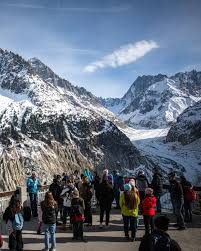Study: Only 24% present-day glaciers will remain if world gets warmer by 2.7°C

A striking new study has brought a sobering reality to light: if the Earth’s average temperature increases by 2.7°C above pre-industrial levels—a scenario increasingly likely without urgent climate action—only about 24% of the glaciers we see today will remain. This means nearly three-quarters of the world’s glaciers could vanish, reshaping ecosystems, threatening water supplies, and accelerating sea level rise.
Why Glaciers Matter More Than Ever
Glaciers are not just frozen wonders of nature; they are vital to human and environmental well-being. Acting as massive freshwater reservoirs, glaciers feed countless rivers and lakes, especially in mountainous and arid regions. Millions of people rely on glacial meltwater for drinking, irrigation, and hydropower, particularly during dry seasons when rainfall is scarce.
Beyond freshwater, glaciers help regulate local and global climate patterns. They reflect sunlight, helping to keep the planet cool, and their melt contributes to ocean circulation systems. The loss of glaciers, therefore, has far-reaching consequences that go well beyond the melting ice itself.
What Does the Study Show?
This recent research, published by an international team of scientists, used a combination of satellite data, climate modeling, and glacier mass balance measurements to project the future of glaciers under various warming scenarios. The results are alarming: if global temperatures rise by 2.7°C, only about a quarter of current glaciers will survive.
The findings are especially critical for some of the world’s most glacier-dependent regions:
- The Himalayas: Often called the “Third Pole” due to their vast ice reserves, Himalayan glaciers supply water to over a billion people. The study predicts significant shrinkage here, threatening water security for countries such as India, Nepal, and Bhutan.
- The Andes: South America’s longest mountain range depends heavily on glacier-fed rivers. Melting glaciers could disrupt water availability in countries like Peru, Chile, and Bolivia.
- The Alps: Europe’s iconic glaciers are rapidly retreating. Reduced glacial ice will impact tourism, local water supplies, and ecosystems.
- The Arctic: The polar glaciers and ice caps are melting faster than anywhere else on Earth, with consequences for sea levels and global climate feedback loops.
Why Is This Meltdown Happening?
The Earth’s glaciers have been shrinking for decades due to rising temperatures driven by greenhouse gas emissions. As the planet warms, glaciers lose more ice during summer than they gain during winter, leading to a net loss in mass. The higher the temperature rises, the faster the glaciers melt.
A 2.7°C rise might seem like a small number, but on a global scale, it represents a massive shift in the Earth’s energy balance. This increase can accelerate melting rates, causing glaciers to retreat at unprecedented speeds.
The Ripple Effects of Losing Glaciers
The disappearance of glaciers will cause cascading impacts on both natural systems and human communities:
- Rising Sea Levels: Glacial meltwater contributes significantly to sea level rise. As glaciers shrink, the added water in oceans raises levels, putting coastal cities at risk of flooding, erosion, and storm surges.
- Water Scarcity: Many regions depend on glacier melt during dry periods. Without this reliable water source, agriculture could suffer, leading to food insecurity. Drinking water availability will also decrease for millions.
- Ecosystem Disruptions: Glaciers create unique habitats. As they vanish, plant and animal species adapted to cold, glacier-fed environments face extinction or displacement.
- Economic Challenges: Hydropower generation, agriculture, and tourism industries linked to glaciers face direct threats. Loss of glaciers could lead to job losses and reduced economic activity in affected areas.
What Can We Do to Prevent This?
While the study paints a grim picture, it also reinforces the urgent need for climate mitigation and adaptation strategies. To protect glaciers and the ecosystems and communities that rely on them, immediate global efforts are necessary:
- Accelerate Emission Reductions: Transitioning to clean, renewable energy sources and increasing energy efficiency are critical. Cutting carbon dioxide and other greenhouse gases can slow warming and reduce glacier melt.
- Strengthen Climate Policies: Governments need to implement and enforce climate policies aligned with limiting warming to 1.5°C or below, as per the Paris Agreement targets.
- Invest in Adaptation: Communities that depend on glaciers must prepare for changing water availability by improving water management systems, enhancing storage, and developing drought-resistant crops.
- Promote Research and Monitoring: Continuous monitoring of glaciers through satellites and on-ground measurements can provide early warning signs and help shape better conservation strategies.
- Raise Awareness: Public understanding of glacier loss and climate change can increase support for policies and personal actions that reduce carbon footprints.
Looking Ahead: A Fragile Future for Glaciers
The study’s warning that only 24% of glaciers could remain with 2.7°C warming should serve as a wake-up call. The consequences of glacier loss are profound, affecting water security, ecosystems, economies, and global sea levels. However, this outcome is not inevitable.
The future of glaciers depends on our actions today. By aggressively reducing emissions and preparing for unavoidable changes, humanity can slow glacier retreat and protect this vital part of our planet’s natural heritage.
The clock is ticking, but there is still hope. Preserving glaciers means preserving life-supporting water, biodiversity, and climate stability for future generations.






